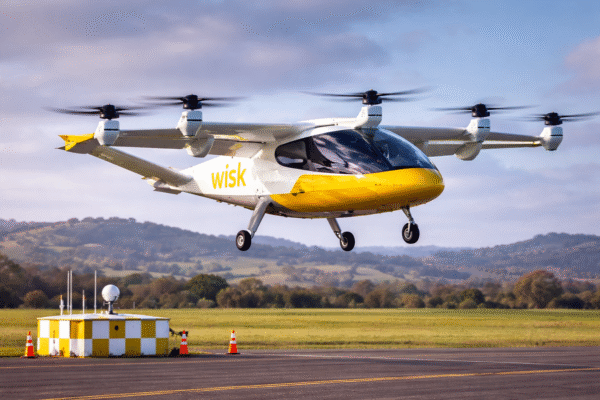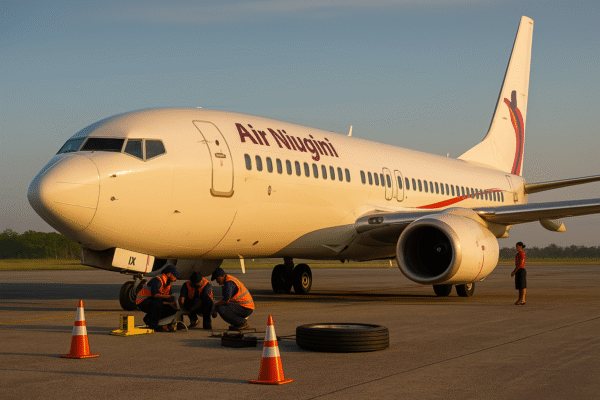In the early hours of July 17, 2025, Air Niugini’s Boeing 737-800, operating as Flight PX011 from Manila, encountered an unexpected setback upon touchdown at Port Moresby’s Jacksons International Airport. At approximately 8:25 AM local time, one of the aircraft’s main landing gear tyres began to deflate during the rollout. Thanks to the calm professionalism of the flight crew and the airline’s stringent safety protocols, the jet came to a controlled stop on the runway, ensuring that every passenger and crew member remained unharmed.
Within moments, cabin staff reassured travelers aboard PX011, keeping them informed and secure in their seats. Simultaneously, the cockpit crew coordinated with air traffic control and Air Niugini’s operations center to enact the airline’s emergency response plan. Passengers received water and light refreshments while ground handling teams prepared to assess the issue. The swift communication channels between cockpit, cabin, and support staff underscored the carrier’s commitment to passenger welfare and operational excellence.
Leading the technical response, a team of Air Niugini engineers and ground mechanics deployed airside maintenance equipment directly on the runway. After a rapid but thorough inspection, it was determined that replacing the deflated tyre in situ would minimize further delays across the airport’s tightly managed schedule. By 9:15 AM, the faulty wheel assembly was successfully removed and a fresh tyre fitted, all under the watchful coordination of airport emergency services and airline safety officers.
As soon as the replacement was complete, PX011 was carefully towed to the adjacent international terminal apron, arriving by 10:08 AM. This efficient runway-to-apron transition allowed Jacksons International Airport to clear its sole runway and resume normal flight operations shortly thereafter. During the maintenance window, inbound flights faced brief holding patterns, while several diverted to Lae International Airport—a regional hub approximately 300 kilometres north—before returning once the runway reopened.
For outbound travelers scheduled on PX011, Air Niugini’s customer service team had arranged refreshment vouchers, onward travel assistance, and liaison with travel agents. A spokesperson for the airline extended apologies for the inconvenience and commended the joint efforts of airport staff, emergency responders, and its own crew. The airline reinforced that passenger safety is its paramount concern and expressed gratitude for the understanding shown by its clientele.
Local tourism stakeholders, including the Papua New Guinea Tourism Promotion Authority (TPA), hailed the incident as a testament to the robustness of PNG’s aviation infrastructure. In a statement, the TPA noted that while any disruption can ripple through inbound tourism schedules—impacting everything from group tours to individual leisure travellers—the rapid restoration of services helped avoid significant setbacks for the broader travel ecosystem in Port Moresby and beyond.
Industry analysts point out that the Manila–Port Moresby route plays a critical role in linking Southeast Asian markets with PNG’s rich cultural and natural attractions—from the highlands treks to coastal diving sites. Even minor flight interruptions can affect tour operator logistics and advance bookings, but in this case, the sub-two-hour delay proved largely manageable. Travel insurers reported only a modest uptick in minor claims for reimbursement, with most visitors encountering minimal disruption to their planned itineraries.
This tyre deflation episode serves as a reminder of the rigorous maintenance regimes essential to modern air travel. Airlines like Air Niugini conduct daily tyre-pressure inspections, rotational schedules for landing gear components, and simulated emergency drills. Coordination with airport authorities ensures that firefighting units, rescue teams, and ground handlers remain on standby to tackle unforeseen events without jeopardizing safety or passenger confidence.
Looking ahead, Jacksons International Airport plans to review its runway inspection protocols and enhance real-time monitoring systems for gear anomalies. Air Niugini, for its part, will incorporate insights from this incident into its training modules and technical bulletins. Such continuous improvement cycles are vital in an industry where even the smallest mechanical hiccup can have outsized operational consequences.
As normalcy returned to Port Moresby’s airside, Flight PX011 eventually departed for its next rotation on schedule, carrying with it a reaffirmed sense of trust between passengers and the airline. In an era where reliability is as prized as comfort, the seamless handling of this tyre deflation underscores the travel sector’s resilience—and its steadfast dedication to ensuring every journey remains both safe and timely.
Read more aviation stories- follow Global Travel Wire.
Disclaimer: This image is AI generated and may bear no resemblance with actual fact or images.



















